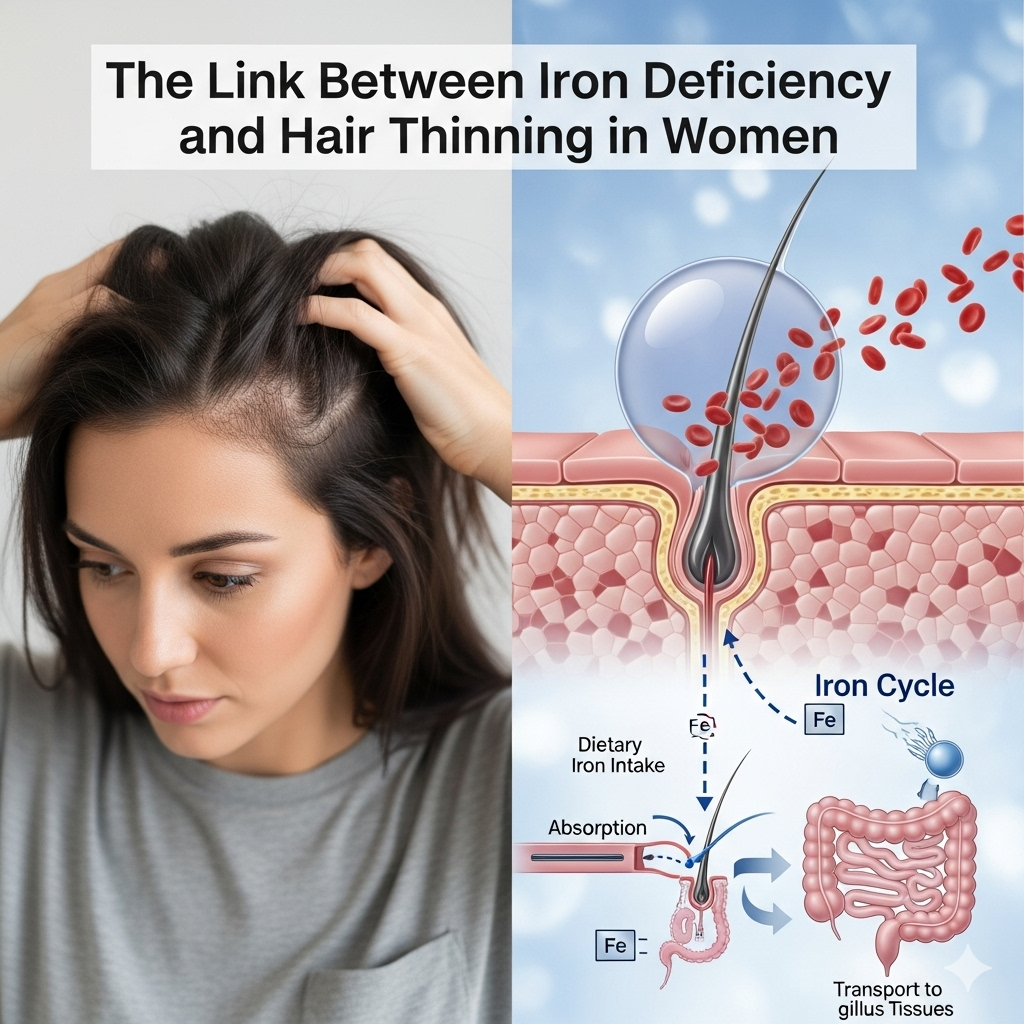Hair thinning in women can be a distressing and emotionally taxing experience. It impacts self-esteem, confidence, and overall well-being. While many factors contribute to female hair loss—including genetics, hormones, and stress—one often-overlooked cause is iron deficiency. At ZMD Hair, we believe in addressing the root causes of hair thinning, not just the symptoms. Understanding the role of iron in hair health can be the key to restoring not only your hair but also your sense of self.
In this blog, we’ll explore the science behind iron deficiency and its connection to hair thinning in women, symptoms to watch for, and how proper diagnosis and treatment can help restore healthy hair growth.
Why Iron Matters for Hair Health
Iron is an essential mineral that plays a vital role in the body’s overall function, including oxygen transport, cellular energy production, and DNA synthesis. But its importance doesn’t stop there—iron is also critical for healthy hair follicle function.
Hair follicles are among the most metabolically active cells in the body. They require a consistent supply of oxygen and nutrients to sustain the hair growth cycle. Iron helps produce hemoglobin, a protein in red blood cells that transports oxygen to tissues—including the scalp and hair follicles. When iron levels are low, follicles may not receive enough oxygen, which can disrupt the hair growth cycle and lead to excessive shedding or thinning.
How Iron Deficiency Contributes to Hair Thinning
Iron deficiency doesn’t always present with obvious symptoms like fatigue or dizziness. In many women, hair thinning can be the first noticeable sign. Here’s how it happens:
Disruption of the Hair Growth Cycle
Hair growth occurs in three stages: anagen (growth), catagen (transition), and telogen (resting). Iron deficiency can shorten the anagen phase and trigger a shift toward the telogen phase, resulting in telogen effluvium—a condition marked by diffuse hair shedding.
Oxygen Deprivation at the Follicle
Without adequate iron, hemoglobin levels drop, leading to reduced oxygen delivery to hair follicles. This impairs their ability to produce new strands of hair and weakens the ones already growing.
Reduced Enzyme Function
Iron-dependent enzymes are responsible for cellular repair and growth within the follicle. When iron is scarce, enzyme activity slows, making it difficult for follicles to function properly.
Who Is Most at Risk?
Iron deficiency is one of the most common nutritional deficiencies worldwide, and women are disproportionately affected. The following groups are at increased risk:
- Menstruating women: Monthly blood loss depletes iron stores.
- Pregnant or postpartum women: Increased iron demands during and after pregnancy can trigger deficiency.
- Vegetarians and vegans: Plant-based iron is less bioavailable than animal sources.
- Women with heavy periods: Excessive menstrual bleeding can drain iron levels quickly.
- Women with GI disorders: Conditions like celiac disease, ulcers, or IBS can impair iron absorption.
At ZMD Hair, we always evaluate potential underlying causes of hair thinning—especially for women who fall into these risk categories.
Symptoms Beyond Hair Loss
Iron deficiency doesn’t just affect your hair. If you’re experiencing hair thinning, be on the lookout for these additional signs that could indicate an iron deficiency:
- Fatigue or weakness
- Pale skin
- Brittle nails
- Cold hands and feet
- Headaches or dizziness
- Shortness of breath
- Unusual cravings for ice, dirt, or starch (a condition called pica)
These symptoms may be subtle, but they’re red flags that your body—and your hair—may not be getting the nutrients they need.
Diagnosis and Testing
Hair thinning may prompt a visit to a dermatologist or trichologist, but blood work is essential for identifying iron deficiency. The most accurate test is a serum ferritin test, which measures your body’s stored iron. While “normal” levels vary, research shows that women with hair thinning often need a ferritin level of at least 50 ng/mL to support healthy hair regrowth.
At ZMD Hair, we collaborate with your healthcare providers to ensure thorough diagnostics, including full iron panels, thyroid testing, and nutritional assessments, before developing a personalized restoration plan.
How to Treat Iron-Deficiency Hair Thinning
Reversing iron deficiency can often stop or even reverse hair thinning. But it requires a strategic and supervised approach.
Iron-Rich Diet
Boost your iron intake with foods like:
- Lean red meat
- Spinach and kale
- Lentils and beans
- Pumpkin seeds
- Quinoa
- Iron-fortified cereals
Pairing iron-rich foods with vitamin C (like citrus or bell peppers) can enhance absorption, while avoiding coffee and calcium around meals can prevent interference.
Supplementation
For more severe deficiencies, dietary changes may not be enough. Oral iron supplements—especially those containing ferrous sulfate—can restore levels over time. However, they should be taken under medical supervision to avoid gastrointestinal side effects or overcorrection.
Topical and Clinical Treatments
While correcting iron levels addresses the root cause, many women also benefit from complementary hair regrowth strategies such as:
- Minoxidil: Helps jumpstart follicles into the growth phase.
- PRP Therapy: Platelet-rich plasma promotes follicle healing and regeneration.
- Nutritional support: Biotin, zinc, and amino acids can complement iron therapy.
- Scalp health treatments: Address inflammation and circulation issues.
At ZMD Hair, our customized restoration plans blend nutrition, medical therapy, and advanced treatments to give your hair the best chance of recovery.
Conclusion: Don’t Overlook Iron Deficiency in Your Hair Loss Journey
Hair thinning isn’t just about vanity—it’s often your body’s way of signaling an internal imbalance. Iron deficiency remains one of the most underdiagnosed causes of hair thinning in women, despite being easily treatable. If you’re noticing more strands in your brush, on your pillow, or in the shower drain, it may be time to consider whether low iron is part of the problem.
At ZMD Hair, we don’t offer one-size-fits-all solutions. We start with a thorough diagnostic process, including evaluating your iron status, then design a hair restoration plan tailored to your needs—blending science, nutrition, and clinical expertise.
Ready to take control of your hair health?
📞 Call ZMD Hair today or book your consultation online to uncover the root causes of your hair thinning and start your journey toward fuller, healthier hair. Let’s get to the root—together.




